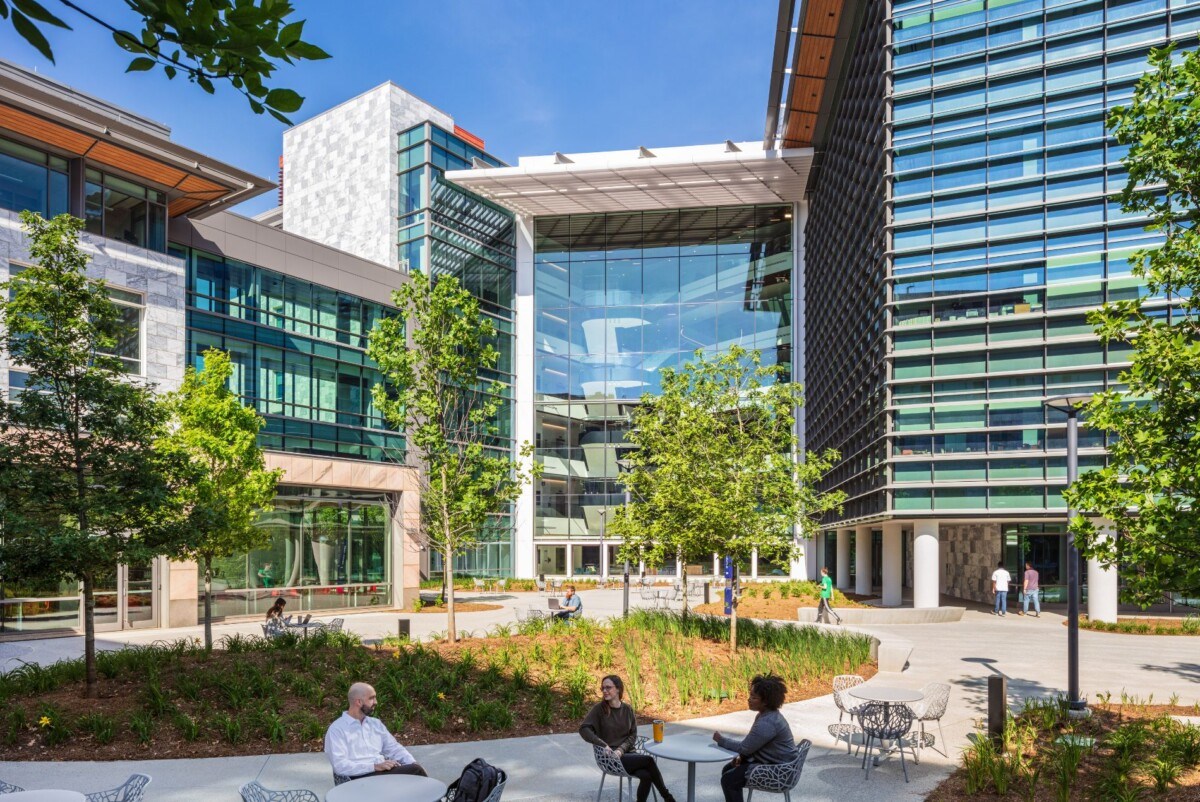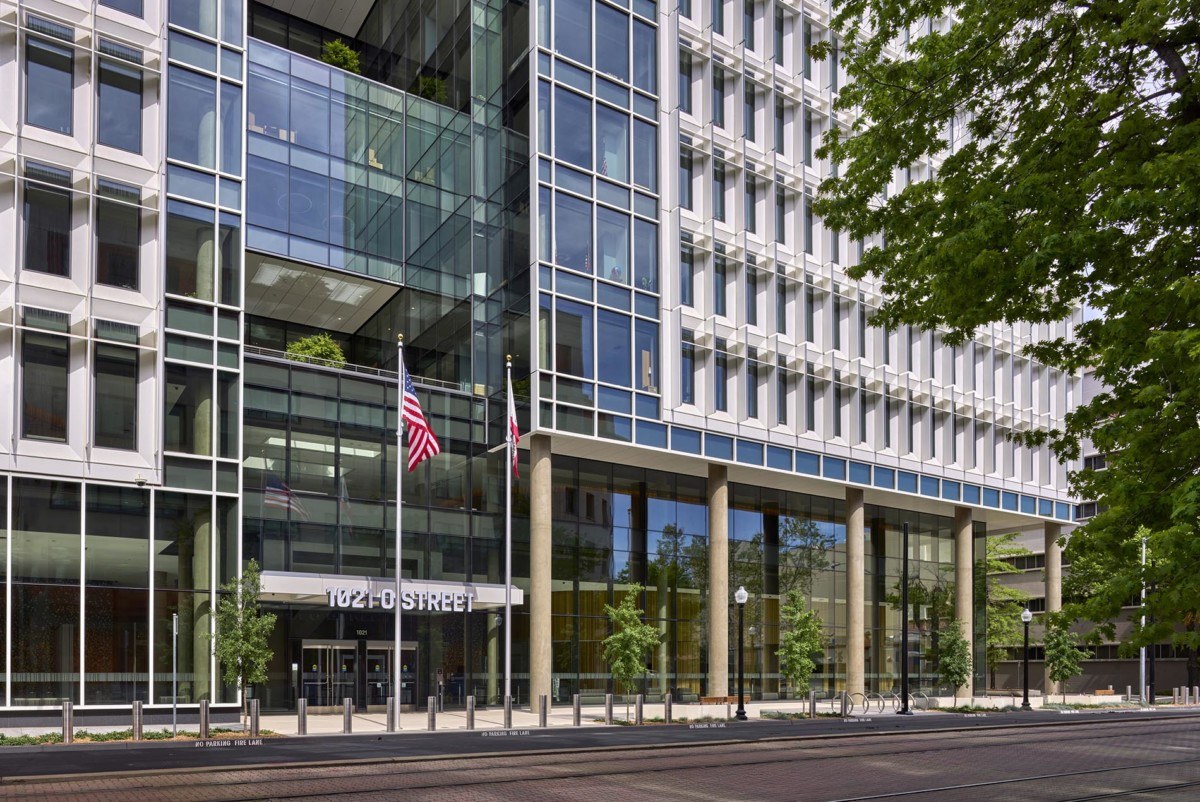Signed into law in August 2022, the historic Inflation Reduction Act (IRA) directed $370 billion toward combating climate change through clean energy and energy efficiency investments. As we pass the one-year mark, the IRA is already exceeding expectations in catalyzing building owners and the private sector to upgrade systems, install renewable power and slash carbon emissions.
To get an insider’s view on the progress made over the past year, we spoke with HOK Director of Sustainable Design Anica Landreneau, ASSOC. AIA, LEED AP BD+C, WELL AP. She describes how the IRA’s incentives and synergies with regulations like building performance standards create ideal conditions for rapid progress in sustainable building design and decarbonizing existing structures.
The IRA has now been law for over a year. What’s your assessment of its impact so far, especially concerning buildings and energy efficiency?
Anica: The results have surpassed projections. Ed Mazria’s recent Architectural Record article reported that U.S. building emissions dropped 8.4% in the first half of 2023 compared to 2022, with coal power generation falling nearly 30%. Applications for tax credits related to technologies like solar, microgrids and heat pumps are coming in at much higher rates than the government anticipated. There is an enormous opportunity right now to invest in decarbonizing our new and existing building stock with these unprecedented incentives available.

Emory University Health Sciences Research Building II
Can you provide some examples of how building owners are taking advantage of the financial incentives?
The IRA introduced game-changing reforms that allow nonprofits and public entities to benefit directly from tax credits for sustainable technologies. For example, universities previously couldn’t take full advantage of credits for installing technologies like geothermal energy or electrochromic glass. Now, they can claim these incentives directly rather than selling off tax credits at a reduced value. One of our current university clients purchased eligible electrochromic glazing technologies during construction to get the IRA rebate upfront instead of waiting until the project was complete. For other institutional owners, state or local gap funding may help pay for upgrades for later reimbursement, like what NYSERDA is doing in New York. The IRA also established a Green Bank to provide gap financing where local funding is not available.
You’ve indicated that regulations are creating important market signals as well. How do those regulatory drivers interact with the IRA incentives?
Building performance standards established in cities like New York and Washington, D.C., send a powerful signal that building owners must improve energy efficiency and decarbonize existing properties or face penalties. Despite economic uncertainty in the commercial real estate market, most buildings impacted by these policies are already on track for compliance ahead of schedule, as both cities have reported. The incentives in the IRA are critical because some buildings may struggle to qualify for lender financing to make necessary upgrades. The IRA provides financial support to help comply with building performance standards cost-effectively. The incentives and regulations work hand-in-hand to accelerate progress on decarbonization. I’d urge stakeholders to “run, don’t walk” and take advantage of these opportunities now. The IRA has made funding available to invest in existing buildings, which represent our biggest opportunity for rapid emissions reductions.
How have changes in building occupancy and use during the pandemic affected energy consumption and emissions?
The pandemic led many buildings to operate at reduced occupancy for an extended time. Facility managers learned to fine-tune systems for lower loads while maintaining indoor air quality and performance. We’re seeing some persistent benefits even as occupancy increases again. Workplaces aren’t being used the same as pre-pandemic, with more hybrid and flexible arrangements. Buildings turned down or partially occupied on a given day can leverage these lessons to save energy. While pandemic impacts were challenging, they provided an unexpected opportunity for owners to identify nuanced operational improvements and behaviors that reduced energy waste. Those lessons can now be applied for ongoing efficiency gains.

10th and O Street State Office Building
Why is HOK so well-suited to helping owners navigate this changing landscape?
A big differentiator is HOK’s depth of knowledge across architecture, engineering, planning, landscape architecture and interior design. Many firms don’t have the comprehensive multidisciplinary expertise to handle complex challenges like developing an integrated carbon reduction master plan across an extensive portfolio of assets. Our building sector experience also includes market-leading practices in areas like healthcare, higher education, aviation, science and technology, and the workplace. This allows us to bring tailored solutions drawing from lessons and strategies proven to work in those building types.
Which recent projects demonstrate HOK’s integrated design approach related to energy efficiency and reduced carbon emissions?
Emory University’s Health Sciences Research Building II in Atlanta exemplifies our foresight in designing for maximum flexibility to slash carbon emissions when needed. Energy efficiency was a priority from the outset of design, and the facility consumes just half the energy of a typical research building. The integrated strategies included thermal programming, leveraging adjacencies for advanced ventilation efficiencies and creating an efficient centralized biorepository to reduce plug loads.
Sacramento’s 10th and O Street State Office Building is another fantastic example. As an all-electric, zero-carbon building, the focus was on full electrification and a dedicated off-site solar array. We leveraged site-specific and community-scale clean energy solutions. The State’s proactive pursuit of full electrification now also avoids costly retrofits as California moves toward electrification mandates.
As we wrap up, what are your predictions in terms of where we go from here on building decarbonization?
The dramatic emissions reductions we’ve already seen highlight that upgrading existing buildings presents our largest opportunity to cut carbon rapidly. Between more performance standards coming online and unprecedented financial incentives available, we’re only scratching the surface of what’s possible. Accelerating building upgrades can spur local job creation, improve public health, advance environmental justice, strengthen communities and tackle climate change. HOK is more committed than ever to pushing the design and construction industry forward to achieve that potential as quickly as possible.
